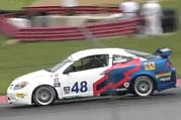BUILDING UP SPEED
Cobalt Racing

By Don Shilling
Racing teams help improve the street performance of the Chevrolet Cobalt
LEXINGTON, Ohio — The Chevrolet Cobalt is tearing up the race track, leading a nationwide series called the Koni Challenge.
Taking the checkered flag is nice, but the real place that Chevrolet wants to be No. 1 is on Main Street. Racing helps it reach that goal, said John Barrick, senior manager of race vehicle engineering for General Motors.
“GM’s small cars historically have not been the best. We lost that segment to the foreign brands,” he said Sunday at an event for Cobalt owners at Mid-Ohio Sports Car Course.
Placing the Cobalt on the track against models from BMW, Acura and others is part of GM’s effort to reassert itself in small cars. With more buyers shifting to fuel-efficient cars, this segment is becoming more important than ever, Barrick said.
“It’s extremely important to us that we not only be competitive, but be superior. It’s critical for our long-term survival,” he said.
This racing season — with a Cobalt leading the Koni series — shows how far GM has come in developing small cars, he said.
“The Cobalt can run toe-to-toe with anyone,” he said. “It gives us an excellent opportunity to reach a segment of the market in which we have to be successful.”
Pushing the Cobalts to their limits on race tracks helps develop new technologies for the production versions, said Pete Bovenberg, a driver for the California Cobalt Team.
Race teams can find the point where brake systems overheat or cooling systems fail, he said. Also, running a car at high speeds in a 21‚Ñ2-hour race tests the complex communication systems that connect the brakes and suspensions with the engine management system, he said.
Each time the car comes off the track, engineers pore over the fault codes that are generated by on-board computers to determine where the systems can be tweaked, he said.
“Racing improves the breed of the car,” he said.
Dwight Woodbridge, program manager for GM’s race teams, said the automaker funds the research for racing technology to help improve the car. Cars are tested in a wind tunnel. They are run on a test track, and they are shaken on a machine to check shocks and suspensions.
The racing teams fund the actual racing of the cars. There are five teams that race seven Cobalts around the country. It costs about $500,000 a year to run a two-car program, not counting the cost of the car, Woodbridge said.
Some of the teams cover their costs by renting the car out to drivers, while others have their own drivers and are out to win, he said.
One of those out to win is Georgian Bay Motorsports, which owns the car that is leading the Koni Challenge. The Canadian company runs two of its own cars, but it also prepares the race cars for the other teams.
It receives shells of the production cars that are built at the GM plant in Lordstown. Georgian Bay installs a carbon fiber hood, trunk lid and doors to lessen and reposition the weight of the car. It also works on the cars’ suspensions, tires and brakes. It installs a roll cage and an instrument panel designed for racing.
It also modifies the engines but not to make them better. The turbo boost of the engine has to be restricted because the standard Cobalt SS engine is too powerful for the race series.
Chevrolet this year replaced the supercharger in the Cobalt SS with a turbocharger, which is designed to improve how compressed air is pumped into the engine. This allows the cylinders to provide more power.
“This new car is so powerful and strong,” said Mike Kuznicki, the owner of Georgian Bay.
Grand Am Cup, the race sanctioning body, wants to keep the cars in the Koni Challenge evenly matched because the series is designed for production cars.
“They are trying to make sure it’s a good show. We’re trying to win every race,” Barrick said.
Among the cars in the Street Tuner series are the BMW 330, Acura TSX, Subaru Legacy, Honda Civic and Mazda RX-8.
Last Sunday, the top Cobalt team finished seventh out of 46 cars. The finish earned the Georgian Bay team enough points, however, that it remained in first place for the series. It had won two of the first three races in the series.
shilling@vindy.com
 43
43
